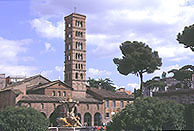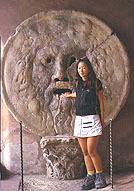From the Tiber Island to the Ghetto
St. Maria in Cosmedin
 One of our favorite churches: medieval and very austere.
One of our favorite churches: medieval and very austere.
Outside. The bell tower is a fine example of Medieval brick work: seven stories of windows with baby columns, and plates or porphyry discs stuck into the facade.
Inside. The sparse interior has not been changed in character since the 1100s. All the columns and capitals come from Roman times. In the Dark Ages, there was a gallery for women to worship upstairs out of the men's way.
The rood screens (between the altar and public area) and the glorious floor are particularly fine examples of the Cosmati technique of mosaic-like decorative patterns.
The altar is a porphyry bath from Roman times! Porphyry marble mines ran dry in 100 BC. Very appreciated for its dark purple salami color, all pieces made since then have been carved out of other sculpted pieces.
In the sacristy is an 8C mosaic on gold ground, originally in the old St. Peter's.
![]() Cosmati in Cosmedin. "In Cosmedin" means cosmetics, therefore beautiful, in Greek. In the 12C AD the then revolutionary use of broken Roman artifacts assembled into beautiful surfaces became the height of fashion.
Cosmati in Cosmedin. "In Cosmedin" means cosmetics, therefore beautiful, in Greek. In the 12C AD the then revolutionary use of broken Roman artifacts assembled into beautiful surfaces became the height of fashion.
The Cosmati family (did their name come from the church?) were in a lucrative business for 200 years creating these fabulous floors.
| St. Maria in Cosmedin History Legend. Aeneas is supposed to have settled here once he arrived from Troy. 495 BC. On these marshlands stood a massive altar and Temple to Hercules. 69-81 AD. Under the Flavian Emperors a columned hall was built for inspectors of the grain, fruit and vegetable market (Forum Holitorium) just outside. They checked that customers did not get cheated. Nearby was the stable of thoroughhbreds for the chariot races in Circus Maximus. Also a Temple to Mithras where charioteers could pop in for a prayer before the race. 200 AD. A tiny chapel below ground, thought to be part of the foundations of the temple (now the crypt), was built for worshippers who risked death to come here. 6C. A small church was erected for Rome's Greek population. 772. Pope Adrian I enlarged and beautified the building, for the flood of Byzantine refugees from Constantinople escaping the Iconoclastic persecutions (when worship of images was forbidden). 1223. Restored again, and the floor redone, perhaps the first Cosmati floor. |
Piazza Bocca della Verità
Bocca della Verità

(Mouth of Truth). Ancient Roman giant marble disc sculpted into a human face. This used to be a drain. (How nice to have functional drains be beautiful and funny).
Tradition has it that if you put your hand into the mouth and tell a lie, it will bite your hand off. We know that a priest used to hide behind the marble face and whack the wrists of known liars, making them yelp with pain.
A favorite place for mothers with unruly children, and wives with unfaithful husbands.
Piazza Bocca della Verità